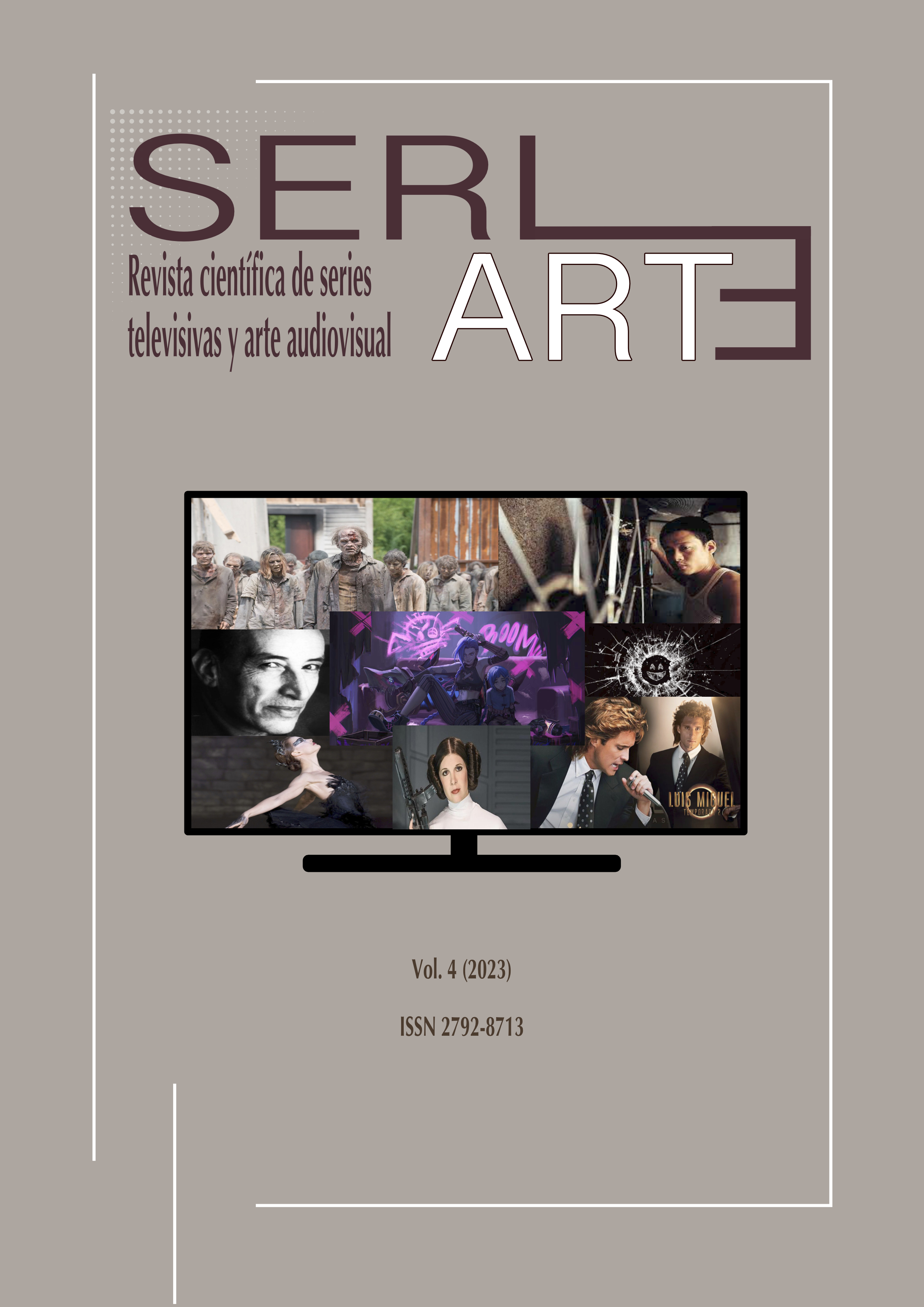‘Everybody Wants to Be My Enemy’: Popular Music and Transmediality in Arcane
Main Article Content
Abstract
The popularization of Arcane, released in 2021 on Netflix, has gone hand in hand with the billboard success by Imagine Dragons, Enemy. The series' soundtrack is rooted in previous musical commodities produced by Riot Games, whose growing interest in expanding the e-sports market through transmedia strategies has been reflected in the increasing weight of its non-playable products. The series proposes a confrontation between the members of two socioeconomically contrasting cities, which, along with the relationship between its protagonists and the selected music for its illustration, brings the imagined reality of the show closer to the daily experience of its audience. The suggested analysis and the collection of the participants' experiences in the transmedia phenomenon shows how the strategy followed by the developer has effectively impacted the consumption of both the video game and the music of the artists involved in the confection of its Original SoundTrack.
Downloads
Publication Facts
Reviewer profiles N/A
Author statements
Indexed in
- Publisher
- Ucopress. Cordoba University Press
Article Details

This work is licensed under a Creative Commons Attribution-NonCommercial-NoDerivatives 4.0 International License.
References
ACHARTS (n.d.), «Enemy», at <https://acharts.co/song/166818> (date accessed: 14-04-2023).
BAUDRILLARD, Jean (1993), Symbolic Exchange and Death, London: Sage.
BECKER, Judith (2004), Deep Listening: Music, Emotion, and Trancing, Bloomington: Indiana University Press.
BLACK-CAT-OF-ZAUN (2022), «[Lore Spoilers] Leimotifs in Aracane’s Score», at <https://www.reddit.com/r/arcane/comments/s5y7xq/lore_spoilers_leitmotifs_in_arcanes_score/> (date accessed: 14-04-2023).
DÍAZ GASCA, Juan Sebastián (2013), Music Beyond Gameplay: Motivators in the Consumption of Videogame Soundtracks (Doctoral Thesis), Griffith University, at <https://research-repository.griffith.edu.au/bitstream/handle/10072/367483/Diaz%20Gasca_2015_02Thesis.pdf?sequence=1> (date accessed: 14-04-2023).
FARRIS, Hunter (2019), «How Imagine Dragons Writes Such Memorable Melodies», at <https://flypaper.soundfly.com/write/how-imagine-dragons-writes-such-memorable-melodies/> (date accessed: 14-04-2023).
FEBRER COLL, Eulalia (2020), «‘Living Like Giants’: from the screen to the stage», JoSSIT: Journal of Sound, Silence, Image and Technology, n.3, pp. 71-88.
IMBD (n.d.). «Imagine Dragon: Premios», at <https://www.imdb.com/name/nm4995251/awards> (date accessed: 14-04-2023).
JEFFERY, Alex (2017), «Marketing and materiality in the popular music transmedia of Gorillaz’ Plastic Beach», Revista Mediterránea de Comunicación, vol. 2, n.8, pp. 67-80. DOI: https://doi.org/10.14198/MEDCOM2017.8.2.5
JENKINS, Henry (2006), Convergence Culture: Where Old and New Media Collide. New York: New York University Press.
JENKINS, Henry (2009), Fans, blogueros y videojuegos: La cultura de la colaboración. Barcelona: Paidós.
KAMBEROVIC, Rijad (2023), «League of Legends Player Count: Here Are The Stats», at <https://riftfeed.gg/more/player-count> (date accessed: 14-04-2023).
LEAGUE OF LEGENDS (2021), «Worlds 2021 Show Open Presented by Mastercard: Imagine Dragons, JID, Denzel Curry, Bea Miller, PVRIS», at <https://www.youtube.com/watch?v=1OzoFq4Q3_c> (date accessed: 14-04-2023).
MARTÍN NÚÑEZ, Marta & NAVARRO REMESAL, Víctor (2021), «La complejidad ludonarrativa en el videojuego: Un doble boomerang», L’Atalante, 31, pp. 7-30.
NATTRESS, Katrina (2021), «Imagine Dragons’ New Song Enemy’ Sounds Like Nothing They’ve Done Before», at <https://www.iheart.com/content/2021-10-28-imagine-dragons-new-song-enemy-sounds-like-nothing-theyve-done-before/> (date accessed: 14-04-2023).
OXFORD LEARNER’S DICTIONARY (n.d.), «Lore», at <https://www.oxfordlearnersdictionaries.com/definition/english/lore> (date accessed: 14-04-2023).
PORTA-PÉREZ, Alberto (2022), «La supradiégesis Musical en el Sistema de Combate de los JRPG», Transactions of the Digital Games Research Association, vol. 6, n. 1, pp. 35-60. DOI: https://doi.org/10.26503/todigra.v6i1.129
RAMBARRAN, Shara (2016), «“Feel Good” with Gorillaz and “Reject False Icons”: The Fantasy Worlds of the Virtual Pop Group and Their Creators», in WHITELEY, Sheila and RAMBARRAN, Shara (eds.), The Oxford Handbook of Music and Virtuality, New York: Oxford University Press, pp. 148-168. DOI: https://doi.org/10.1093/oxfordhb/9780199321285.013.15
RICHARDSON, John (2012), An Eye for Music: Popular Music and the Audiovisual Surreal, New York: Oxford University Press. DOI: https://doi.org/10.1093/acprof:oso/9780195367362.001.0001
RIOT GAMES (n.d.), «Explore & Discover Runaterra», at <https://map.leagueoflegends.com>, (date accessed: 14-04-2023).
SÁNCHEZ-OLMOS, Cande & VIÑUELA, Eduardo (2019), «Transmedia storytelling, music and videogames: The case of Los Ríos de Alice by Vetusta Morla and Delirium Studios», Icono14, vol. 1, n.17, pp.60-82. DOI: https://doi.org/10.7195/ri14.v17i1.1242
RAMOS DE MESQUITA, Alice (2022), «A transmidiação com uma estratégia de imersão no universo dos jogos eletrônicos: Uma análise sobre Arcane» (Undergraduate Dissertation), Universidade General de Pernambuco.
RIOT GAMES MUSIC (2022), «Making Enemy with Imagine Dragons, Arcane Soundtrack, Riot Games Music», at <https://www.youtube.com/watch?v=dDWBK3oYGuQ> (date accessed: 14-04-2023).
SCOLARI, Carlos A. (2014), «Más allá del pentagrama: transmedia y música», at <https://hipermediaciones.com/2014/01/19/transmedia-y-musica/> (date accessed: 14-04-2023).
SHARER, Happy (2023), «What is Enemy by Imagine Dragons: Exploring the Themes of Fear and Oppresion», at <https://www.lihpao.com/what-is-enemy-by-imagine-dragons-about/> (date accessed: 14-04-2023).
STEIN, Mônica (2016), «Relações entre Games e Franquias Transmídia. Até onde o mercado interfere?», XV SBGames, São Paulo, Anais eletrônico, pp. 1340-1346, at <http://www.sbgames.org/sbgames2016/downloads/anais/159702.pdf> (date accessed: 14-04-2023).
STREAM WARS (2021), «Making of ARCANE – Best of Behind The Scenes, League of Legends, Netflix Original Series (2021)», at <https://www.youtube.com/watch?v=7rAbZUZCnL8> (date accessed: 14-04-2023).
TAN, Amanda (2022), «How Imagine Dragons wrote Arcane’s opening song ‘Enemy’ using only two chords», at <https://www.oneesports.gg/league-of-legends/imagine-dragons-arcane-enemy/> (date accessed: 14-04-2023).
TOP CHARTS (n.d.), «Enemy: League of Legends, JID, Imagine Dragons», at <https://www.top-charts.com/s/enemy-imagine-dragons-jid-league-of-legends> (date accessed: 14-04-2023).
WEINREICH, Frank (2012), «The Fantastic is Not Fantastic: On the Relationship Between Fantasy and Reality», in SCHMEINK, Lars and MÜLLER, Hans-Harald (eds.) Fremde Welten. Wege und Räume der Fantasie im 21. Jahrhundert, Berlin: De Gruyter, 1-15.






